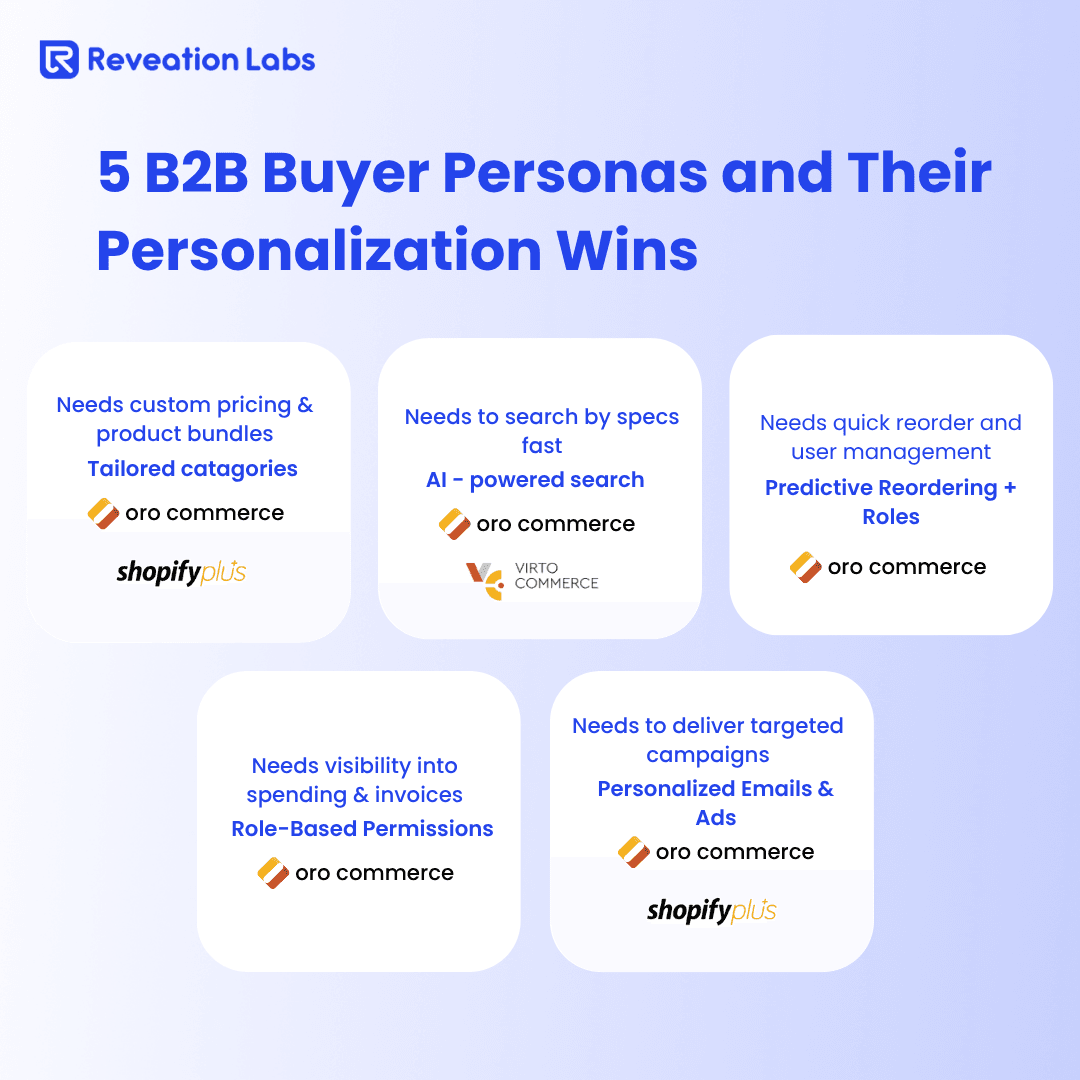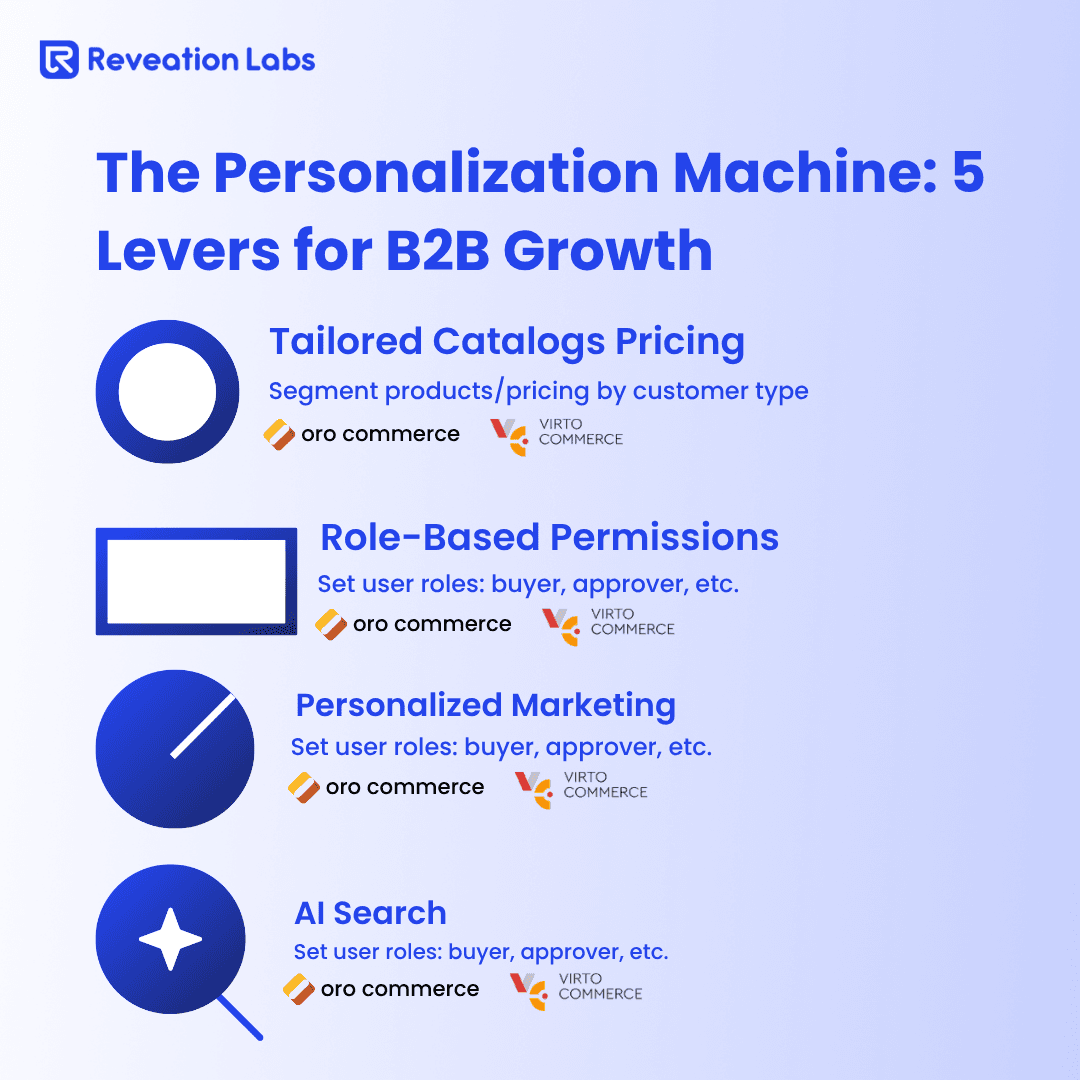Introduction: The Imperative of Personalization in B2B
B2B buyers expect the same personalized, on-demand experiences they see in their shopping. Research shows that about two-thirds of business buyers now expect as-good-or-better personalization in their professional purchases as they get in their consumer lives. Personalizing a B2B storefront – from recommended products to tailored pricing – makes customers feel “seen” and builds trust. That trust translates directly into loyalty and faster sales: companies investing in personalization often see double-digit revenue growth (McKinsey found 10–15% and, in some cases, up to 25% growth from personalization). In complex B2B buying cycles (often involving 6+ stakeholders), every personalized touchpoint helps move deals forward. In short, B2B sellers that offer B2C-like tailored experiences accelerate engagement, shorten decision time, and win repeat business.

Quick Win #1: Tailor Product Catalogs and Pricing
Strategy: Divide your customers into segments (by industry, purchase history, contract terms, etc.) and show each group a custom catalog of products and prices. For example, a distributor might show a construction company a catalog focused on bulk building supplies, while a retailer sees packaged goods. You can even apply volume or contract discounts automatically for each segment.
- Platform Insights:
- OroCommerce: Its built-in segmentation engine lets you create unlimited catalogs and price lists per customer segment. As Oro documentation notes, you can manage multiple websites/segments from one back-end and “create unlimited catalogs and price lists” to display the right products and prices for each segment. In practice, Oro makes it easy to set up, say, a unique price list for “Gold” customers or a special catalog for a particular industry.
- Shopify Plus: The B2B/Wholesale features of Shopify Plus allow custom catalogs and prices by customer. In the admin, you can create B2B catalogs that include selected products and set overall price adjustments or fixed prices for specific products. For example, one retailer’s site might use a 20% discount catalog for a preferred wholesaler (reducing a $10 product to $8). By managing these catalogs in Shopify’s admin, you deliver a tailored assortment and pricing to each account.
Quick Win #2: Implement Role-Based Access and Permissions
Strategy: Reflect your customer’s purchasing process by assigning roles to different users (e.g., buyer, approver, accountant). Each role should have only the permissions they need – for instance, buyers can add items to the cart, approvers can place orders, and finance staff can view invoices. This keeps each team member in their lane and speeds up approvals.
- Platform Insights:
- OroCommerce: Supports multiple users per customer account with granular roles. Out of the box, Oro includes roles like Administrator and Buyer, and lets you create new customer user roles with specific storefront permissions. For example, you might assign a “Buyer” role to department purchasers (can add to cart) and an “Approver” role to managers (can finalize orders). Each role’s actions – viewing quotes, creating orders, etc. – are configurable in Oro’s back office.
- Virto Commerce: Also offers flexible role and permission control. In Virto’s model, administrators define roles as collections of permissions, and then assign one or more roles to each user. This means you could create roles like “Purchaser” and “Approver” and grant them different edit/view rights. As Virto explains, a single role can be given to many users (and vice versa), making it easy to map your organization’s hierarchy. This granularity ensures the right people see and do exactly what they should in the portal.
Quick Win #3: Enhance Search Functionality with AI
Strategy: Upgrade your site search so it understands natural-language queries and buyer intent. An AI-driven search can correct misspellings, infer related terms, and rank results based on what similar customers have done. For example, if a customer types “replacement filters”, the search should know to return air or water filters even if those exact words aren’t used. Smarter search keeps users engaged: Valtech notes that AI-enhanced search (with natural language understanding and personalized results) can boost conversion rates by roughly 30% and average order value by 25%.
- Platform Insights:
- OroCommerce: Offers AI-powered vector search capabilities. Its vector-search feature uses AI models to understand query intent and synonyms, even across languages or misspellings. In practice, this means Oro can integrate tools like LangChain or OpenAI so that buyers can search in plain English (or their own language) and get relevant results. In short, Oro’s vector search brings advanced AI to your catalog search, helping buyers find products faster.
- Virto Commerce: Provides AI-backed search as well, leveraging semantic search. Virto’s B2B platform includes “AI-powered tools such as semantic search” to make procurement more efficient. In other words, Virto can combine keyword search with AI-driven understanding of meaning so that a customer’s needs (even if expressed loosely) map to the right products. Both platforms’ AI search means less hunting and more accurate matches for your users.
Quick Win #4: Streamline Reordering Processes
Strategy: Make repeat buying frictionless. Enable one-click reorders from past orders, let customers save and name shopping lists of frequently ordered items, and show predictive suggestions for what they’ll need next. For example, a maintenance manager should be able to grab last month’s order with one click, and the system might suggest replacing related parts. By simplifying reorders, you boost loyalty: Oro’s analysis notes that saved lists and timely recommendations “build trust” and support long-term customer satisfaction.
- Platform Insights:
- OroCommerce: Supports saved shopping lists and AI-driven recommendations. In Oro, you can create multiple shopping lists (e.g., “Quarterly Restock”, “Lab Supplies”) and allow users to order directly from those lists. The platform’s recommendation engine can also surface complementary products based on the customer’s purchase history or industry usage. So buyers get personalized predictive suggestions (e.g., “customers who bought X also needed Y”) right in the reorder process.
- Virto Commerce: Includes wishlist and order cloning features. Virto lets users maintain wishlists (and even share them across a team) so recurring items stay organized. It also has a “Clone order” option to duplicate a past order for rapid checkout. Together, these tools let a repeat customer grab their favorite products or copy an old order in seconds, without rebuilding it from scratch. (For example, a wholesaler could simply clone last month’s bulk order and adjust quantities as needed.)
Quick Win #5: Personalize Marketing Communications
Strategy: Use customer behavior data to tailor your outbound messaging. Track what each business customer browses or buys and use that to customize emails or ads.
For instance, if a buyer spent a lot of time looking at metal fasteners, send them a targeted email featuring fastener-related products. The goal is behavior-based segmentation: treat each contact according to their expressed interests.
Also Read: B2B eCommerce for Manufacturers
- Platform Insights:
- BigCommerce: The “Personalize” app provides real-time tracking for one-to-one content. It analyzes page views, time on page, and recency to rank each contact’s product interests on the fly. You then integrate this with your email or CRM system so that each email dynamically pulls in that contact’s top products. In practice, BigCommerce merchants using this can automatically send hyper-personalized emails and even Facebook ad audiences based on each buyer’s current interests.
- Shopify Plus: Its native B2B features let you customize the storefront and checkout per customer. Shopify’s B2B suite allows you to set up each company with its own pricing, catalog, currency, and even store content. In effect, you can tailor the entire shopping journey for different buyers. For marketing, this means you can send customers to a version of the store that already reflects their needs (pricing, language, etc.), and you can use Shopify Flow to trigger customized email flows or ads based on their account’s activity. The end result is that every B2B customer sees a storefront and checkout that feels built just for them.

Conclusion: Embrace Personalization for Competitive Advantage
These five tactics – custom catalogs, role-based access, AI search, streamlined reorders, and personalized outreach – all remove friction from the B2B buying process. When customers find exactly what they need (in their own catalog, at the right price, and with an easy reorder path), they’re more satisfied and more likely to come back. In fact, studies show that smart personalization can drive dramatically higher conversion and retention.
Each of the platforms mentioned offers built-in features to help. For example, BigCommerce’s apps and OroCommerce’s segmentation tools let you tailor catalogs; Oro and Virto both let you configure fine-grained roles; and both platforms have AI search plugins. By leveraging what BigCommerce, OroCommerce, Virto Commerce, and Shopify Plus already provide, you can launch these quick wins without a massive overhaul.
In the end, winning in B2B means meeting each business customer’s expectations for a modern, personalized experience. Companies that move fast to implement these ideas will stand out – as one analysis put it, B2B organizations that embrace AI-powered search and personalization “will dominate the market,”. Use this playbook to boost engagement, earn loyalty, and accelerate your sales in the quarters ahead.
Through strategic B2B eCommerce consulting, companies can unlock quick personalisation wins that boost engagement, loyalty, and conversions within just a quarter.
Want to Deliver Customized B2B Experiences?!
Reveation Labs Makes It Possible.






